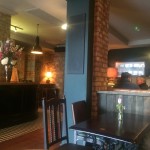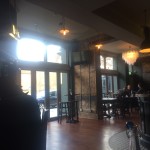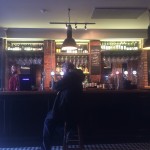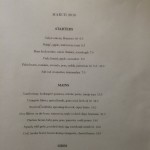You can spot the onset of new London gastropubs a mile off: the stripped back antique raw brickwork, the shabby chic vintage tables, ditto mirrors on the wall, the heritage colours (teals standing out from matt blacks), subdued lighting, bar relocated to a central island, the pile of gourmet scotch eggs and/or pork pies selling for a fiver a time, the display of craft beers in bottle and on draft, not to mention obscure single malt whiskies and other premium spirits.
The service is somewhere halfway between traditional pub barman and table waiting with drinks brought to you, the brightened loos with designer hand gel and a large display of dried flowers, the menus on blackboards everywhere…. which will typically include a fair sprinkling of comfort food dishes, aged steaks and traditional pub favourites, notably fish and chips plus Sunday lunches – though thankfully the latter will be cooked better than the grey beef with packet gravy of yore.
These will be interspersed with fancier titles and global recipes – multiple food cultures often finding themselves on the same plate – in an attempt to remain hip and trendy, all the better for the chef to get noticed and reviewed, thence to move on to a bigger restaurant venture and carry with him (or her) a loyal following. Prices will typically be in £12 to £20 bracket per main course, the cheapest being the de rigueur veggie option.
Sound familiar? I recently reviewed a very similar pub called the Londesborough. I have a love-hate relationship with gastropubs: love because the standards of food and drink can be high without the pretension and fussiness of aspiring if not ambitious restaurants – though that means beer prices are pumped up by 50% and expensive menus are added from the old days. Indeed, the stripped-back style might appeal to some punters, and is undoubtedly a big improvement on brewery makeovers of old, though it means losing the more homely appearance of traditional pubs, acquired over many decades.
The price of progress maybe, but if it preserves the life of these establishments they are worthy of support. The downside is that some will fail, as do a good proportion of all new restaurants, and then it is down to the developers to transform the premises. In some cases, including a lovely old pub in Withington, Manchester, they become supermarkets, which I regard as a crying shame.
The White Lion “pub and kitchen” is a newly reopened pub modelled along precisely these lines, which is inherently neither a good nor a bad thing, nor yet a cliché – though heading in that direction. The bar island is probably indicative that customers prefer to be seated in clandestine fashion near to walls rather than in a more vulnerable location in the middle of the floor, but there it jolly well is.
Service is pretty smart, helped by the fact that at a sample lunch the bar and dining room were yawningly empty but for a few residue regulars. One black mark however for the fact that it took three attempts to find a beer on a working handpump, though the golden ale I eventually plumped for (whose name I have sadly forgotten) was lively and well-kept.
The menu proved pretty much as I expected it to be, prices too. All the trendy boxes are ticked: ham hock, crab, salt cod, rib eye, triple-cooked chips, sprouting broccoli, sourdough, even the grilled calçot onions found at Marcus Wareing’s Gilbert Scott…. need I go on? We selected a veggie option (courgette fritters served with spiced puy lentils, goat curd and herb oil) and a macho number with nods to classic French cuisine (lamb rump, boulangère potatoes, celeriac purée and wilted turnip tops.)
Both were pretty tasty, though the circular fritter got soggier the longer dining went on, not helped by the huge dollop of goat curd atop. The lamb was (correctly) cooked to my order, medium-rare, and clearly came from a fine and frisky young beast. The purée and turnip tops both pleased me, demonstrating a good eye in the kitchen. The boulangère potatoes were, however, far from being the finest example I ever tasted, lacking a crisp topping and without a powerful stock or stewed onion undertone. Very nearly an excellent dish.
We chose from the dessert menu two contrasting numbers which demonstrated the best and worst of The White Lion: honeycomb sundae, which was to me utterly glorious – a perfect light pudding, being sweet and charming without the fussy touches (eg. a spun sugar cage.)
The downside was my pistachio pannacotta, which sadly underwhelmed. It was served in a bizarre and unnecessary tiny kilner jar the size of a medicinal pill bottle, placed upon a slate plate (more fashion accessories) accompanied by glacé cherry biscuits and over-green baked figs, where ripe black figs would surely have been an improvement. None of the three components appeared to be on speaking terms, despite having been introduced at short notice. There was no – what’s the modern word? – synergy.
Clearly there is some promise at the White Lion, whose chef is unknown to me. In some areas it sparkles, but has a little way to go before the menu hits all the top notes and every plate has ingredients that hit it off to perfection. The tendency to serve dishes where the whole was way less than the sum of the parts can be corrected, and I’d recommend that keeping them simple and elegant in order to portray quality ingredients in the best light will work much better than trying to impress by, in the words of the Emperor in Amadeus, “too many notes.” I wish them luck.













